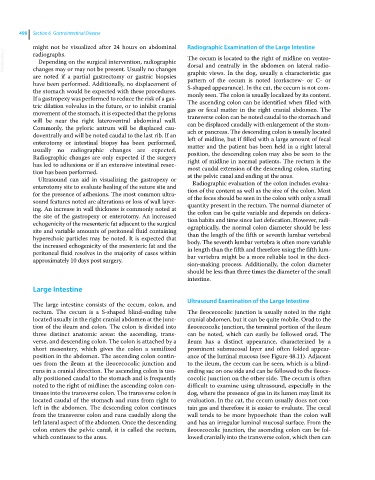Page 530 - Clinical Small Animal Internal Medicine
P. 530
498 Section 6 Gastrointestinal Disease
might not be visualized after 24 hours on abdominal Radiographic Examination of the Large Intestine
VetBooks.ir radiographs. The cecum is located to the right of midline on ventro
Depending on the surgical intervention, radiographic
dorsal and centrally in the abdomen on lateral radio
changes may or may not be present. Usually no changes
are noted if a partial gastrectomy or gastric biopsies graphic views. In the dog, usually a characteristic gas
pattern of the cecum is noted (corkscrew‐ or C‐ or
have been performed. Additionally, no displacement of S‐shaped appearance). In the cat, the cecum is not com
the stomach would be expected with these procedures. monly seen. The colon is usually localized by its content.
If a gastropexy was performed to reduce the risk of a gas The ascending colon can be identified when filled with
tric dilation volvulus in the future, or to inhibit cranial gas or fecal matter in the right cranial abdomen. The
movement of the stomach, it is expected that the pylorus transverse colon can be noted caudal to the stomach and
will be near the right lateroventral abdominal wall. can be displaced caudally with enlargement of the stom
Commonly, the pyloric antrum will be displaced cau ach or pancreas. The descending colon is usually located
doventrally and will be noted caudal to the last rib. If an left of midline, but if filled with a large amount of fecal
enterotomy or intestinal biopsy has been performed, matter and the patient has been held in a right lateral
usually no radiographic changes are expected. position, the descending colon may also be seen to the
Radiographic changes are only expected if the surgery right of midline in normal patients. The rectum is the
has led to adhesions or if an extensive intestinal resec most caudal extension of the descending colon, starting
tion has been performed. at the pelvic canal and ending at the anus.
Ultrasound can aid in visualizing the gastropexy or
Radiographic evaluation of the colon includes evalua
enterotomy site to evaluate healing of the suture site and tion of the content as well as the size of the colon. Most
for the presence of adhesions. The most common ultra of the feces should be seen in the colon with only a small
sound features noted are alterations or loss of wall layer quantity present in the rectum. The normal diameter of
ing. An increase in wall thickness is commonly noted at the colon can be quite variable and depends on defeca
the site of the gastropexy or enterotomy. An increased tion habits and time since last defecation. However, radi
echogenicity of the mesenteric fat adjacent to the surgical ographically, the normal colon diameter should be less
site and variable amounts of peritoneal fluid containing than the length of the fifth or seventh lumbar vertebral
hyperechoic particles may be noted. It is expected that body. The seventh lumbar vertebra is often more variable
the increased echogenicity of the mesenteric fat and the in length than the fifth and therefore using the fifth lum
peritoneal fluid resolves in the majority of cases within bar vertebra might be a more reliable tool in the deci
approximately 10 days post surgery.
sion‐making process. Additionally, the colon diameter
should be less than three times the diameter of the small
intestine.
Large Intestine
Ultrasound Examination of the Large Intestine
The large intestine consists of the cecum, colon, and
rectum. The cecum is a S‐shaped blind‐ending tube The ileocecocolic junction is usually noted in the right
located usually in the right cranial abdomen at the junc cranial abdomen, but it can be quite mobile. Orad to the
tion of the ileum and colon. The colon is divided into ileocecocolic junction, the terminal portion of the ileum
three distinct anatomic areas: the ascending, trans can be noted, which can easily be followed orad. The
verse, and descending colon. The colon is attached by a ileum has a distinct appearance, characterized by a
short mesentery, which gives the colon a semifixed prominent submucosal layer and often folded appear
position in the abdomen. The ascending colon contin ance of the luminal mucosa (see Figure 48.11). Adjacent
ues from the ileum at the ileocecocolic junction and to the ileum, the cecum can be seen, which is a blind‐
runs in a cranial direction. The ascending colon is usu ending sac on one side and can be followed to the ileoce
ally positioned caudal to the stomach and is frequently cocolic junction on the other side. The cecum is often
noted to the right of midline; the ascending colon con difficult to examine using ultrasound, especially in the
tinues into the transverse colon. The transverse colon is dog, where the presence of gas in its lumen may limit its
located caudal of the stomach and runs from right to evaluation. In the cat, the cecum usually does not con
left in the abdomen. The descending colon continues tain gas and therefore it is easier to evaluate. The cecal
from the transverse colon and runs caudally along the wall tends to be more hypoechoic than the colon wall
left lateral aspect of the abdomen. Once the descending and has an irregular luminal mucosal surface. From the
colon enters the pelvic canal, it is called the rectum, ileocecocolic junction, the ascending colon can be fol
which continues to the anus. lowed cranially into the transverse colon, which then can

